Create Your First AI Music Remix Fast
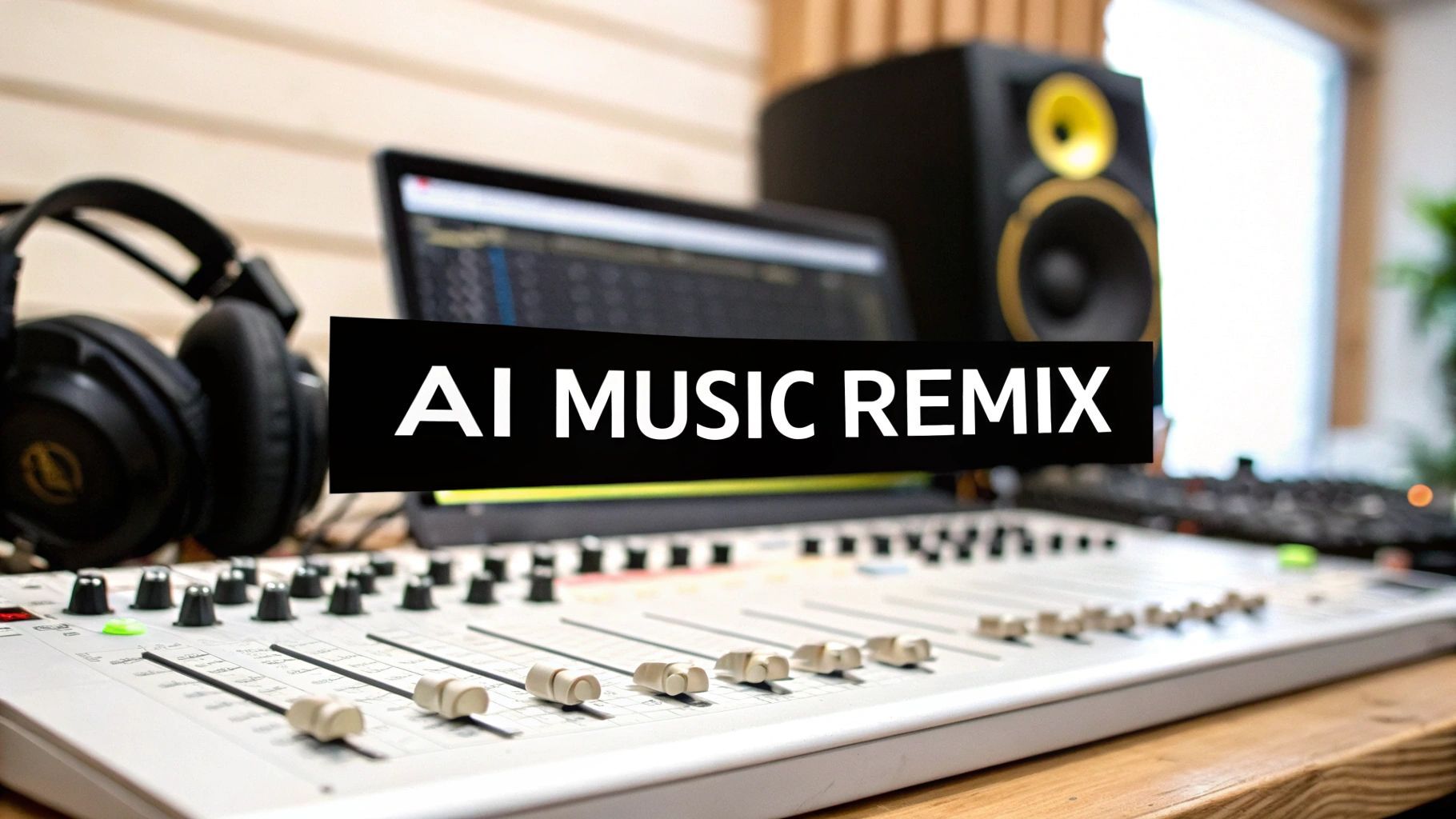
Video Gen Now Faster & Cheaper!


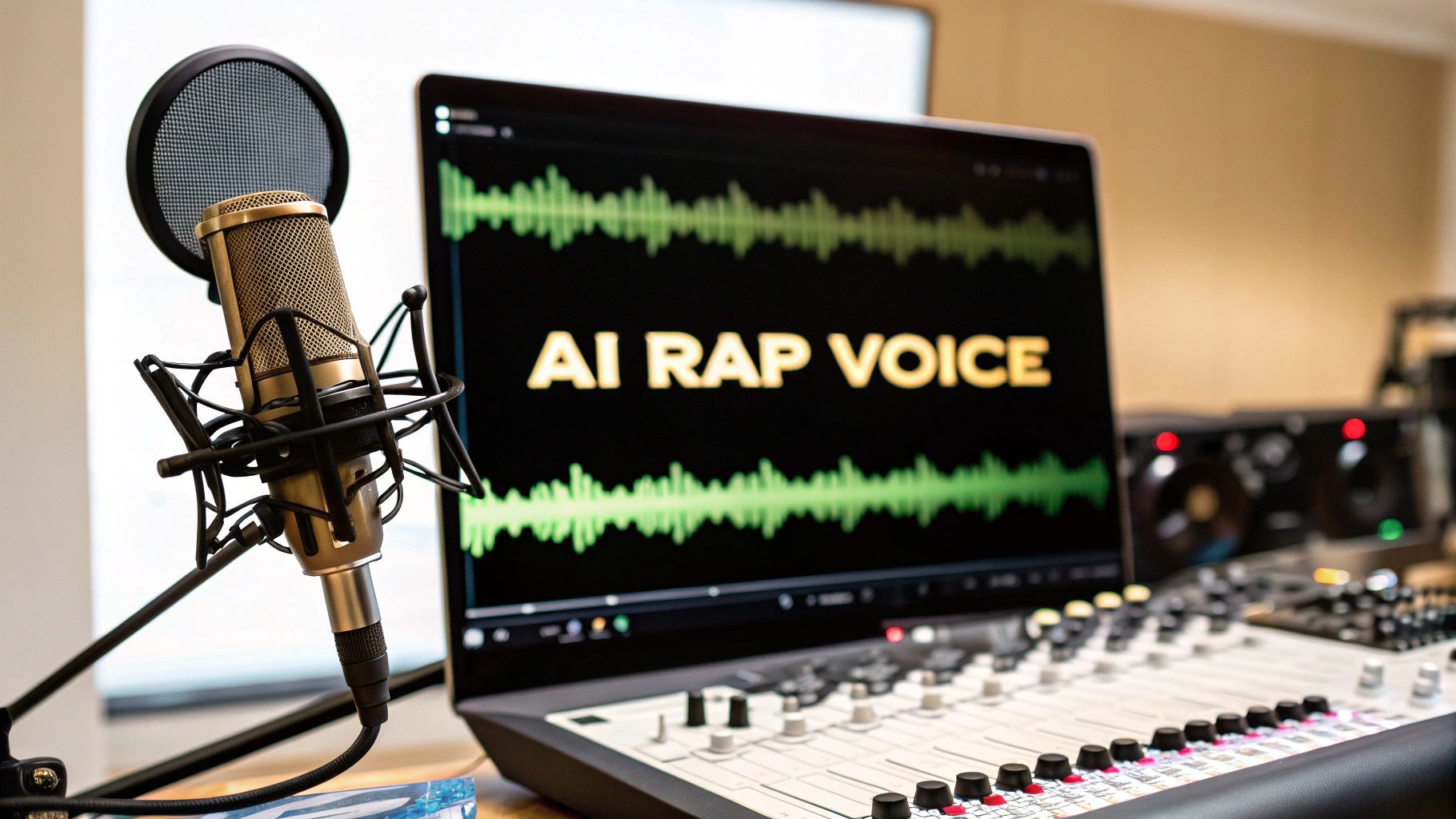
Ready to create an AI rapper voice that sounds authentic? This guide breaks down the process, from prepping lyrics to professional mixing for amazing results.
So, what exactly is an AI rapper voice? Think of it as a synthetic vocal track, cooked up by artificial intelligence to capture the signature style, flow, and vibe of a real rap artist. With platforms like SendFame, you can literally type in your lyrics and get a custom-made rap vocal back in seconds. It’s a wild time to be making music.
Remember the old days? To get a track done, you needed a pricey studio, a sound engineer, and a rapper who actually showed up on time. Those days are quickly becoming a memory. AI isn't some gimmicky toy anymore; it's a serious production tool that's putting real power into the hands of producers, artists, and creators everywhere.
It's all about opening up creative doors. You can now mess around with different flows, test out harmonies, or throw in some ad-libs on the spot, all without booking a single minute of studio time.
This is a game-changer for anyone with an idea:
For Producers: Got a hot beat? Now you can whip up a killer vocal demo in minutes. This makes it way easier to pitch your tracks to artists or just flesh out a full song concept on your own. For Songwriters: Ever wondered how your lyrics would sound when rapped? Now you can hear them performed instantly. It's a fantastic way to tweak your cadence and make sure your rhyme schemes hit just right. For Indie Artists: Working on a tight budget? No problem. You can generate professional-sounding vocals for your projects without having to hire and pay a session vocalist.
This image really captures the new creative landscape. AI tools are becoming as fundamental to the modern studio as a good microphone.
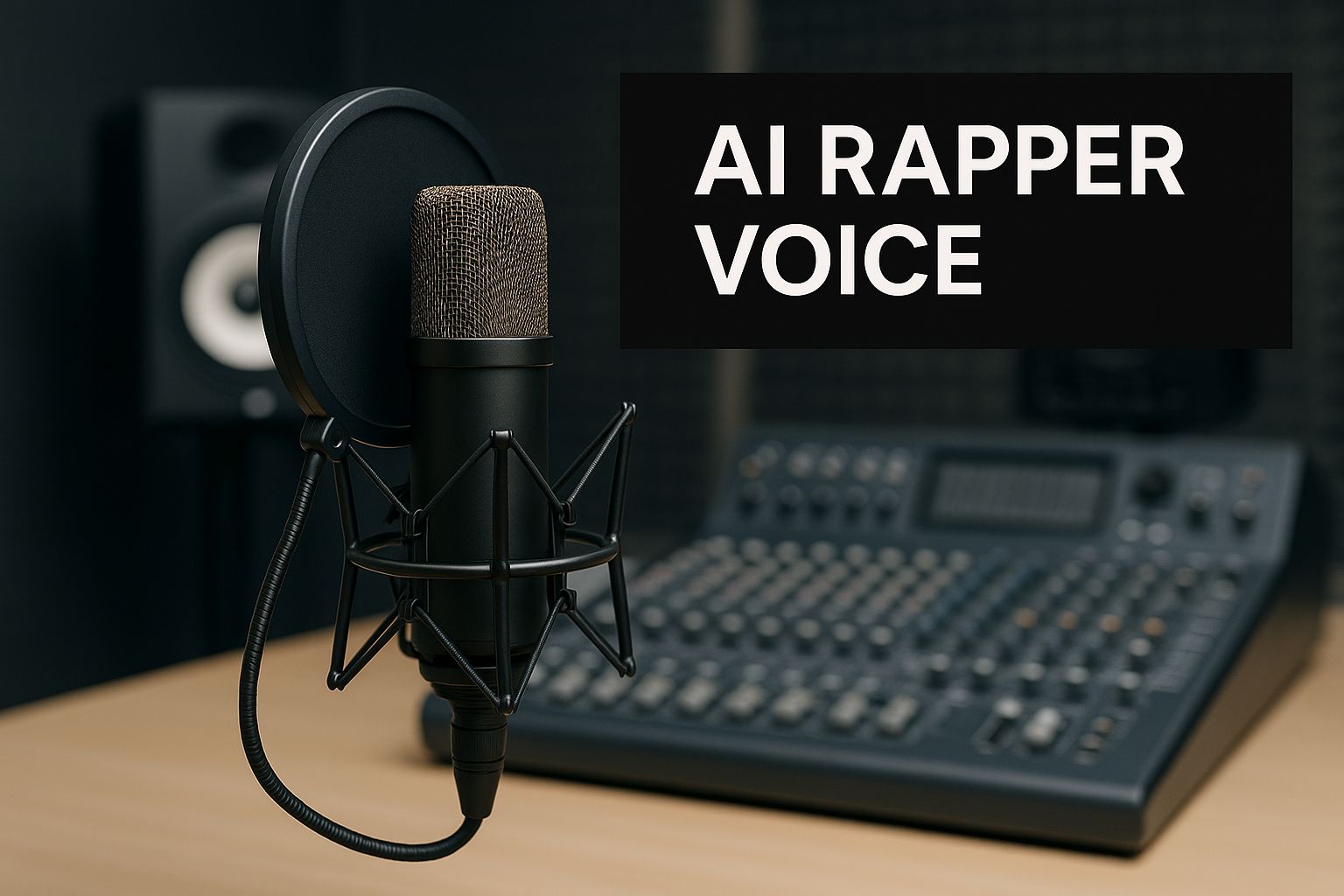
As you can see, the AI rapper voice is right at the heart of today's digital-first recording setup. It’s no longer on the fringes; it’s a core part of the process.
The rise of AI music tools has totally changed the way we work. You can go from a simple lyrical idea scribbled on a napkin to a fully-voiced track in less time than it takes to make a cup of coffee. Seriously.
This speed is everything. It allows you to experiment and iterate at a pace that just wasn't possible before, which is critical in a music scene that moves at the speed of social media. For example, using a tool like our AI rap generator, you can crank out multiple vocal takes with different emotional tones to find the perfect match for your beat.
The numbers behind this shift are just staggering. The AI in music market was already valued at a cool USD 3.9 billion in 2023 and is projected to skyrocket to USD 38.71 billion by 2033.
Here's the real kicker: An incredible 82% of listeners can't even tell the difference between music made by AI and music made by humans. That’s how good the tech has gotten.
This creative explosion isn't just limited to making rap tracks, either. The same technology is fueling all sorts of new tools, including some pretty advanced AI karaoke video makers.
Choosing between an AI-generated voice and a human artist comes down to your project's specific needs, budget, and timeline. Each path has its own distinct advantages and considerations. I've broken down the key differences to help you decide which route makes the most sense for you.
Factor AI Rapper Voice (e.g., SendFame) Traditional Rapper Recording Speed & Efficiency Instant results. Generate vocals in minutes, 24/7. Days to weeks. Depends on artist availability, booking, and recording. Cost Highly affordable. Usually a low subscription or per-track fee. Expensive. Studio time, artist fees, and mixing can cost thousands. Creative Control Total control. Tweak lyrics, tone, and flow with a few clicks. Collaborative. Relies on the artist's interpretation and performance. Consistency Perfectly consistent. The AI never gets tired or has a bad day. Variable. Performance can be affected by mood, health, or environment. Revisions Unlimited and fast. Make endless changes without extra cost. Limited and costly. Re-takes mean more studio time and artist fees. Human Element Lacks the unique "happy accidents" and raw emotion of a human. Delivers authentic, nuanced performances with genuine human feel.
Ultimately, there's no single "best" choice. AI offers unparalleled speed and cost-effectiveness for demos, content creation, and experimentation. Traditional recording, on the other hand, provides the irreplaceable human touch and authenticity needed for major commercial releases. Many producers I know are actually using a hybrid approach—drafting with AI and then bringing in a human artist to lay down the final track.
Alright, let's get your lyrics ready to make some serious noise. Before the AI can spit fire, you need to hand it a solid script. Think of it this way: you're the producer in the studio, and your lyrics are the roadmap for your artist—in this case, a ridiculously talented AI. It's got the chops, but it needs your direction to nail the delivery.
This isn't just about rhyming words. The way you format your text is everything. It dictates the AI's cadence, flow, and overall swagger. A few simple tweaks can take a performance from sounding like a text-to-speech robot to a track that actually goes hard.
Forget what you learned in English class. Here, punctuation isn't about grammar; it's about rhythm. Every comma and period is a direct instruction to your AI rapper on how to breathe and when to pause.
Commas (,) for a quick breath: Toss these in to create short, natural pauses within a line. It’s perfect for breaking up longer bars and giving the flow a more conversational, punchy feel instead of a long, droning sentence. Periods (.) for a full stop: Use a period to signal the end of a bar or a complete thought. This creates a much more defined pause, giving your track that solid, structured backbone. Ellipses (...) for dramatic effect: Want to let a heavy line hang in the air for a second? An ellipsis is your go-to. It tells the AI to pause longer than a comma, injecting a bit of drama or hesitation right where you need it.
For example, "I'm on top of the world never coming down" is just okay. But type it as "I'm on top of the world... never coming down," and you suddenly create a moment of reflection before the punchline. It's a whole different vibe.
Take a look at the SendFame interface. It's designed to make this kind of experimentation a breeze.
The clean layout helps you see your lyrical structure at a glance, so you can tweak punctuation and line breaks on the fly until the flow feels just right.
Let's be real—rappers don't always use perfect, dictionary-approved English. That's where phonetic spelling becomes your best friend. If you want the AI to say "gonna" instead of the formal "going to," just type it out exactly like that. "Whatchu" instead of "what do you." You get the idea.
This is how you give your track authentic flavor.
My Favorite Trick: If you want a word to hit harder, just capitalize it. Writing something like, "I am the GREATEST of all time" signals to the AI that this word needs extra punch. It’s a simple but surprisingly effective way to direct the energy of the performance.
Think about how you'd say the line out loud. Are you slurring words? Are you emphasizing certain syllables? Mimic that in your text. If you hit a creative wall, you can always mess around with an AI lyrics generator for some fresh ideas. It can spit out a solid starting point that you can then polish and format for that perfect AI flow.
Alright, you’ve got your lyrics locked and loaded. Now for the fun part: finding the soul of your track. This is where you get to play producer and audition the perfect AI rapper voice to make those words pop. Platforms like SendFame have a whole library of voices to start with, but the real magic begins when you stop just browsing and start listening with a critical ear.
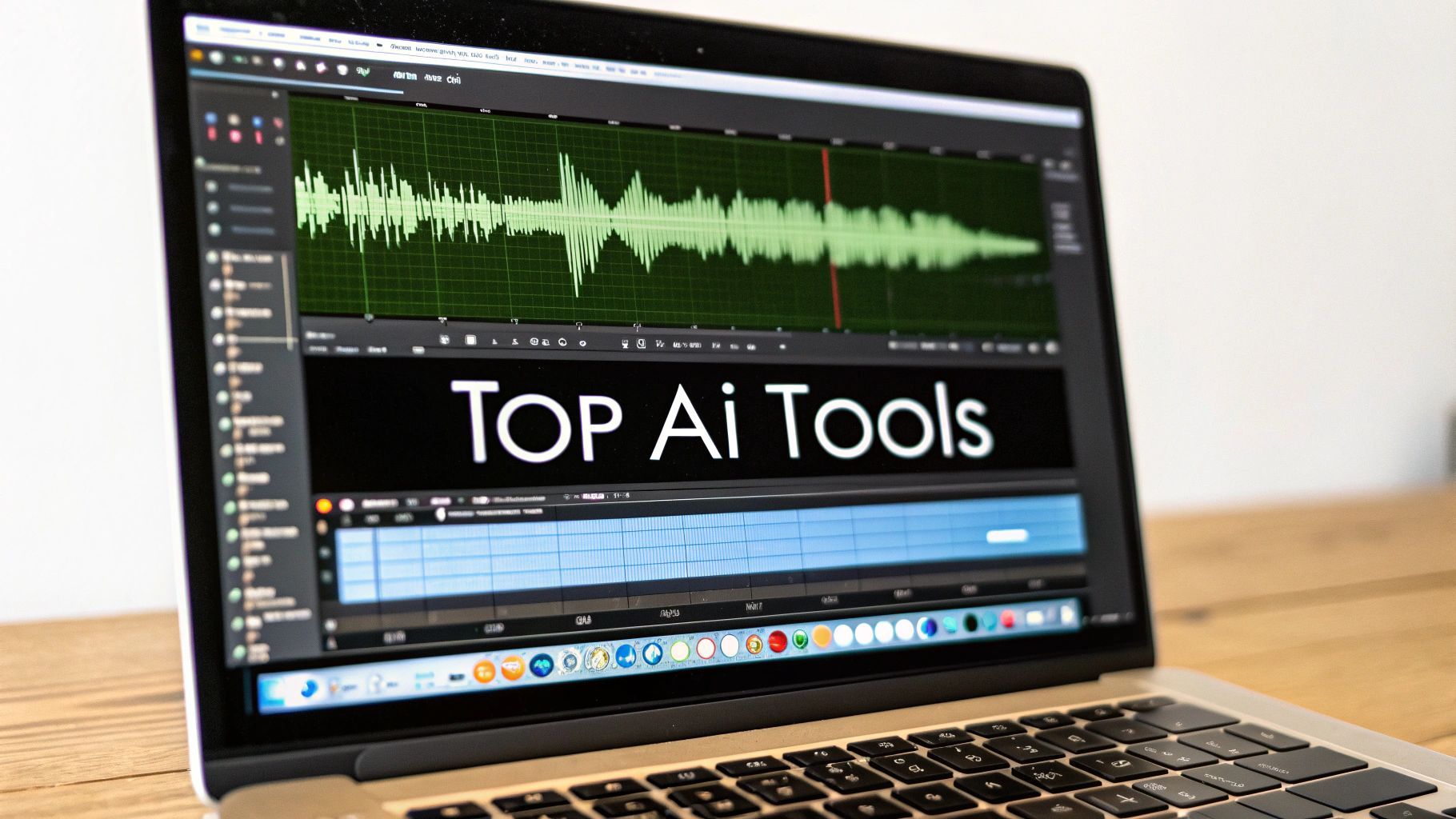
Don't just grab the first voice that sounds "cool." Seriously, close your eyes and imagine it over your instrumental. Does that beat call for a deep, gritty tone with some gravel in it? Or are you aiming for a smoother, more melodic flow that rides the rhythm? Try a few different flavors—energetic and aggressive, laid-back and conversational, whatever feels right.
Remember, this first pick is just your starting point. The real artistry is in bending and shaping that raw voice into something that’s 100% yours.
Think of the AI voice settings as your personal vocal mixing board. This is where you get your hands dirty, tweaking the raw sound until it perfectly matches the vision in your head. Forget the presets; it's time to start sculpting.
Here are the main dials you'll want to be twisting:
Pitch and Tone: Dropping the pitch can give the voice some serious weight and authority. Nudging it up can create a more youthful or hyped-up energy. Even tiny adjustments here can completely change the personality of the voice. Speed and Cadence: Need a line to hit faster for a frantic, double-time feel? Or maybe slow it down for dramatic emphasis? Playing with the speed is how you lock the flow into the pocket of your beat. Emotional Flavor: This is the secret sauce. Modern AI is getting crazy good at injecting genuine feeling into the delivery. A dash of "aggression" on a punchline or a touch of "sadness" in a storytelling verse can make the performance feel incredibly real.
My Take: A great AI rapper voice isn't just about sounding human. It’s about catching the right vibe. The goal is to make people forget they're even listening to an AI and just feel the track.
The technology behind this is exploding. The market for AI voice generators is projected to rocket from USD 4.9 billion in 2024 to a staggering USD 54.54 billion by 2033. That’s a 30.7% compound annual growth rate, which just goes to show how vital this tech is becoming for creators everywhere.
You're not just generating a vocal track; you're creating a character, an artist. Start mixing and matching settings to build a unique persona from scratch.
On one track, I started with a standard mid-range voice, cranked the speed up just a bit, and added a hint of "assertiveness" to craft a super confident, in-your-face lead vocal. It completely owned the mix.
For a different project, a darker storytelling song, I did the opposite. I picked a deep voice, pitched it down even further, and slowed the delivery way down. It created this menacing, deliberate narrator that gave the whole song chills. To get that next-level authenticity, you might want to check out tools that offer ultra-realistic text-to-speech with real emotion.
Don't be afraid to push the sliders to their extremes just to see what happens. Sometimes the weirdest, most unexpected combinations lead to the most interesting sounds. The key is to just keep experimenting until the voice in your head is the one blasting out of your speakers.
Alright, this is where the beat drops and the magic really happens. You’ve got your lyrics prepped and your custom voice dialed in. Now, it's time to actually create your AI rapper voice and hear it come to life. Honestly, this part of the process still feels like a sci-fi movie to me—you feed the machine your words, and a fully-formed vocal track spits back out.
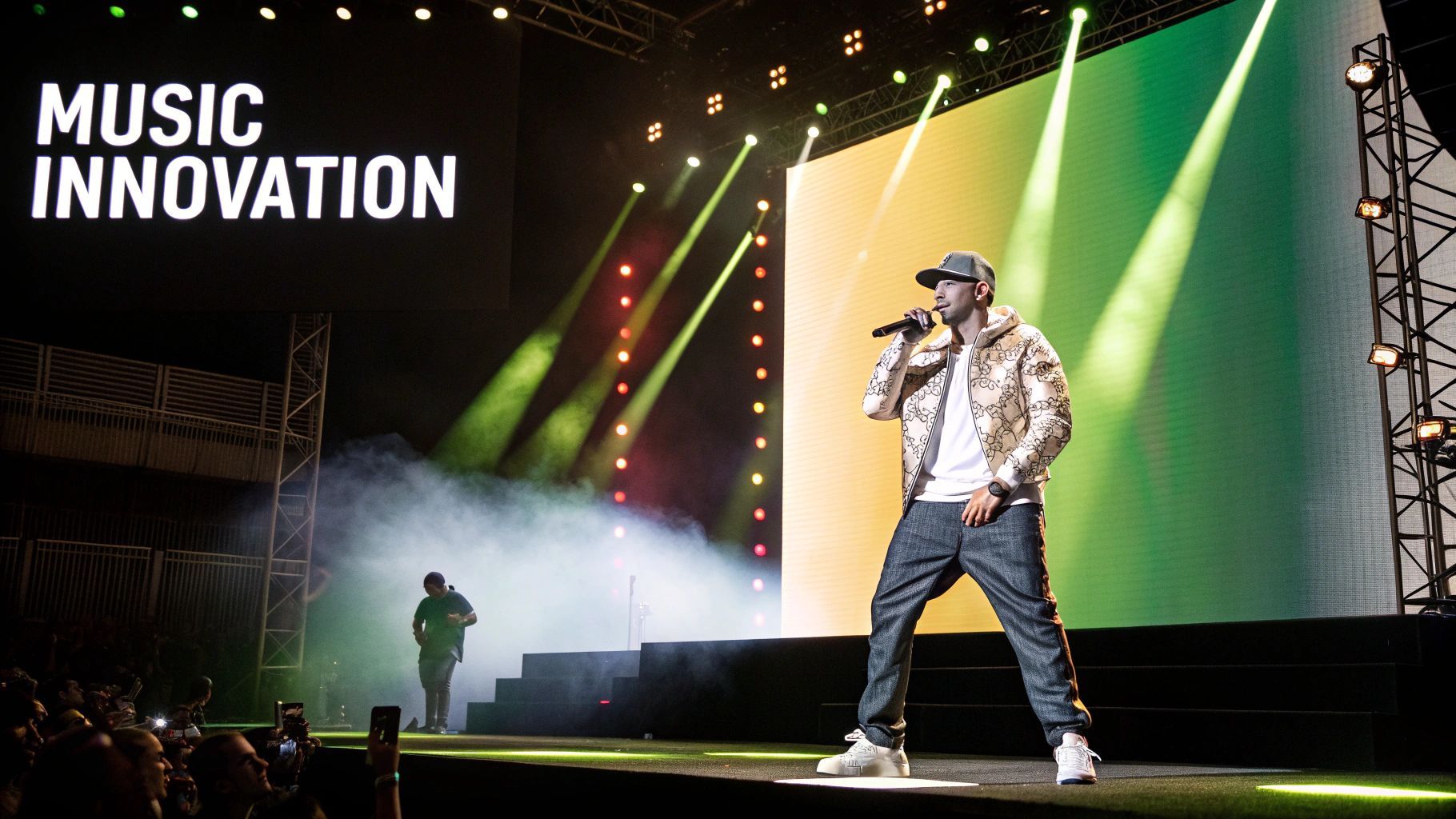
Getting started is a piece of cake. Just grab those lyrics you worked on, paste them into the text box on the SendFame platform, and smash that glorious "Generate" button. In just a few seconds, you'll have your first raw vocal take. But here’s a little secret from someone who's done this a thousand times: your first take is almost never your final one.
This is where you shift from writer to producer. Think of that initial AI output as your lump of clay; now you get to be the sculptor. It's a creative loop that I live by: generate, listen, refine, and repeat.
Don't sweat it if the first version sounds a little janky. Maybe a line feels rushed, or a word doesn’t hit with the right punch. That’s completely normal. The real skill is learning to pinpoint what sounds off and then figuring out why.
Here’s the mental checklist I run through when I'm polishing a raw AI vocal:
Spot the Awkward Phrasing: I listen for anything that sounds clunky or robotic. Does the AI trip over a big word or a complex rhyme? Check the Pocket: Is the vocal sitting right? Does it feel like it's dragging behind the beat or rushing ahead? You're the one who knows the groove, so trust your ear. Listen for the Vibe: Is a hype line coming out too flat? Is a deep, introspective bar sounding too aggressive? The emotion has to match the lyrics.
Once you’ve got your notes, it’s time to jump back in and make some targeted tweaks. This back-and-forth cycle is what separates a decent track from a great one when using any high-quality AI music generator.
My Go-To Pro Tip: Don't generate the whole song at once. Work line by line, or in small chunks like a four-bar verse. This gives you way more control and makes it a breeze to stitch together a flawless final performance from the best parts of different takes.
So, how do you actually fix those little imperfections? You have two main weapons in your arsenal: messing with the input text and fiddling with the voice settings. When you're generating AI vocals, you’re basically directing a performance, much like how you would turn text into podcast episodes using AI by guiding the tone and pacing.
Let's imagine a line like "I'm the king of this whole city" sounds clunky and unnatural. Here are a few tricks I'd try to fix it:
Play with Punctuation: I might change it to "I'm the king... of this whole city" to force a dramatic pause and fix a weird rhythm. Spell it Like You Say it: If the word "city" sounds too clean and proper, I'll try spelling it phonetically, like "ciddy," to get a more authentic, slurred delivery. Tweak the Voice Knobs: Sometimes the line just needs more energy. I'll hop back to the voice customization panel and crank up the "Assertiveness" or "Energy" slider just for that one line's generation.
This constant push and pull is how you truly direct the AI's performance. You’re not just a user pushing a button; you're the producer in the studio, giving notes and coaxing that perfect take out of your digital artist. Keep at it—generating, listening, and tweaking—until every single bar hits exactly the way you hear it in your head.
Alright, you've cooked up a sick AI rapper voice track with SendFame. The flow is tight, the delivery hits hard, and the bars are absolute fire. But hold up—don't hit export just yet. That raw audio file is just the starting point. Now it's time to put on your producer hat and sprinkle on that post-production magic that turns a cool demo into a radio-ready banger.
Think of it like this: your AI vocal is a prime-cut steak. It's fantastic on its own, but to make a truly unforgettable meal, you need to pair it with the right sides—the beat, the 808s, the synth melodies. This is where we blend it all together into something truly special.
A single, lonely vocal track can feel a bit... robotic. No shocker there. The fastest way to breathe life into it is by stacking it with more voices. One of my favorite tricks is to generate a bunch of short, punchy ad-libs as separate files. Think "yeah," "uh-huh," or "let's go."
Once I have them, I drop them into my project on their own tracks. Here’s how I arrange them:
The Main Vocal: This is your star. Keep it dead center, front and proud. Ad-libs & Backing Vocals: Pan these guys out, some to the left, some to the right. This immediately creates a wider, more immersive sound. Then, pull their volume down a bit so they support the main vocal instead of fighting it.
This simple layering technique is a studio staple for a reason. It instantly makes the performance feel more dynamic and human, mimicking the energy of a real recording session with multiple takes.
Your vocal needs its own spot in the frequency spectrum to really cut through the mix. That's where your trusty EQ (Equalization) plugin comes in. Start by gently rolling off the low-end mud from your vocal track—anything below 80-100 Hz can usually go. This gets rid of any rumbling that might clash with your kick and bass.
A clean mix is a pro mix. I’ll often take the instrumental track and scoop out a small notch right where the human voice shines, usually around the 1-3 kHz range. This carves out a perfect little pocket for the AI vocal to sit in, making it pop without having to crank the volume.
Now for the fun stuff—effects! A little goes a long way here.
Reverb: This gives the vocal a sense of space. I'd recommend a short "plate" or "room" reverb to add presence. You want it to sound like it's in a room, not yelling from across a canyon. Delay: A quick, rhythmic echo can add some serious excitement, especially on the last word of a line. Just make sure you sync the delay time to your song's tempo for a clean, professional sound.
We're seeing an explosion in this technology. The Voice AI market is projected to skyrocket from USD 3.14 billion in 2024 to a staggering USD 47.5 billion by 2034. With North America accounting for about 40.2% of that market, it's clear these tools are becoming a core part of the modern creative process. You can dig deeper into the trends driving this Voice AI market boom if you're curious.
Don't be afraid to experiment! Chop up a phrase, reverse a word, or add a stutter edit to create a signature hook. By layering your vocals, using EQ to create space, and adding tasteful effects, you’ll transform that raw AI track into a polished, professional-sounding vocal that’s ready to climb the charts.
Jumping into the world of AI music is exciting, but let's be real—it can also throw a few curveballs your way. It’s a brand-new playground, so it's totally normal to hit a wall or wonder what the rules are. Let’s clear up some of the most common questions I hear about creating an ai rapper voice so you can get back to what you do best: making bangers.
Consider this your personal cheat sheet, built from my own wins and (many) face-palms. The idea is to make the tech feel less like rocket science and more like another tool in your creative arsenal.
This is the big one, and the answer is a huge yes, but with a critical string attached. It all boils down to where you get the voice from. You can't just scrape a voice model from some random corner of the internet and expect to be in the clear.
That's where platforms like SendFame come in. They’ve done the legal legwork for you, offering a library of AI voices that are fully cleared for commercial use. This gives you the green light to drop your track on Spotify, Apple Music, or anywhere else and actually make money from it without constantly looking over your shoulder.
My Two Cents: Seriously, always check the usage rights before you even dream of hitting publish. A few minutes of reading now can save you from a legal nightmare later. That kind of peace of mind is worth its weight in gold.
Getting your AI rapper to sit perfectly in the pocket of your beat is a bit of an art. It's not just about hitting a button; it's a mix of clever lyric prep and some hands-on finessing in your music software.
First, think of your text input as your first shot at setting the timing. As we talked about, using punctuation is your secret weapon. Commas can signal a quick breath or a slight pause, while periods can create those hard, definitive stops. You're essentially programming the rhythm before the AI even gets to work.
Once you have that raw audio file, it's time to pull it into your DAW—whether that's Ableton, FL Studio, or Logic Pro. From there, you can treat it just like a recording from a human artist. Slice it up, nudge phrases forward or back, and lock those vocals tightly to your instrumental. It’s that final human touch that makes all the difference.
Ad-libs are the spice that brings a track to life. That background "yeah!" or "let's go!" can turn a good verse into a great one. The trick is to generate them as separate, individual audio files.
Here’s my go-to process:
Generate short, punchy takes: Think classic ad-libs. "Yeah," "uh-huh," "what," or even just a quick laugh or a sound effect. Keep them short and sweet. Give them their own space: Drag these clips onto new audio tracks in your DAW. Don't just cram them onto the main vocal track. This gives you total control. Create depth and width: This is where the magic happens. Pan some ad-libs a little to the left, others to the right. Slap on a different, shorter reverb than your main vocal to make them feel like they're in a different space. Finally, tuck them into the mix by lowering their volume. This creates that huge, professional, layered sound.
If you want to go even deeper into vocal production, our guide on how to make AI sing a song explores a lot of these same techniques.
Ready to cook up a professional-sounding track in minutes? With SendFame, you can generate a high-quality AI rapper voice, produce custom songs, and even create stunning music videos with just a few clicks. Start bringing your musical ideas to life today at https://sendfame.com.
Create Epic
SendFame